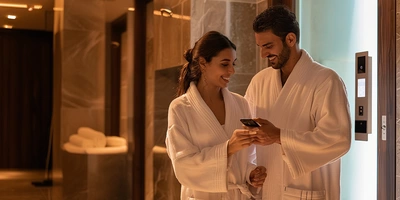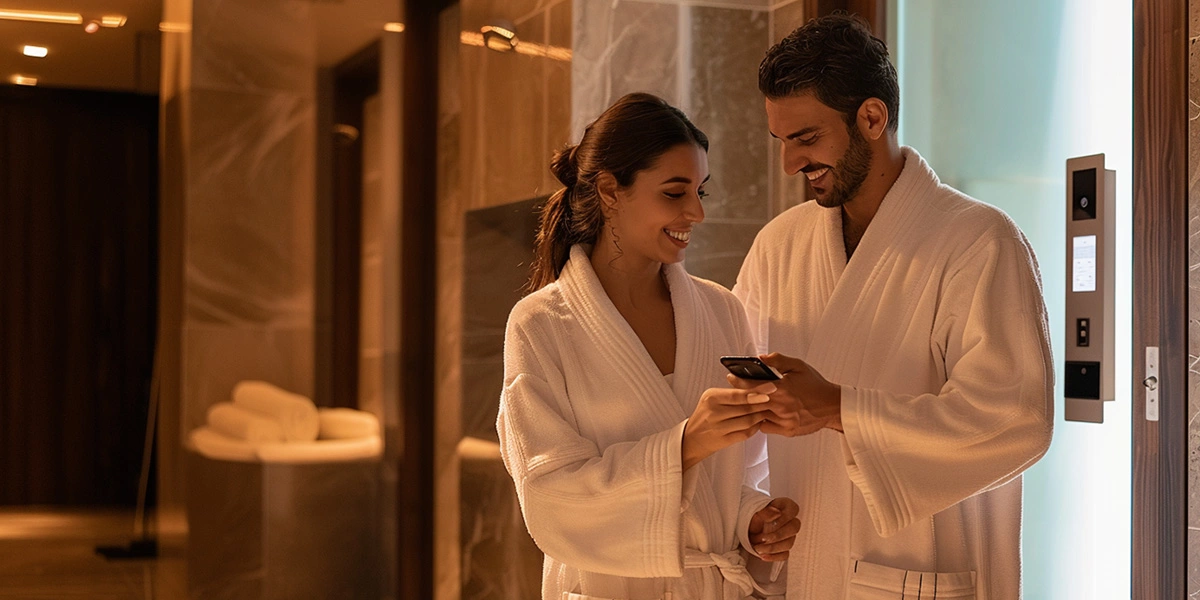Advances in Access Control for the Hospitality Industry


Access control for hotels and resorts has changed a lot over the years, from physical keys to magstripe cards to newer technologies such as radio-frequency identification (RFID) and mobile smartphone credentials. At the same time, access systems have gotten more sophisticated to accommodate the needs of the many different user groups on the property, including guests, staff and third-party vendors and service providers. Here are some of the key advances shaping the future of physical and digital access for the hospitality industry.
The Rise of Mobile Credentials
Mobile credentials are quickly gaining traction in the hospitality industry as more hotels and resorts adopt this technology to enhance guest experiences and streamline operations. According to a 2023 survey, more than 60% of hotel executives globally expect a fully contactless experience, including mobile check-ins and digital keys, to become the industry standard in the next few years. Major hotel brands like Marriott, Hilton and Accor have already rolled out mobile key systems across thousands of properties, while smaller hotels are following suit with similar technologies. Industry experts predict that by 2026, 50% of all hotel rooms across some major chains will support digital keys.
Mobile credentials allow guests to use their smartphones as digital keys to access their rooms, common areas and other hotel services, replacing traditional physical keys or key cards. When guests book a room, they are given the option to check in remotely using the hotel's app or a link sent via email. Upon completing pre-check-in, a digital key is sent to their mobile device, typically through the hotel's app or stored in a digital wallet like Apple Wallet or Google Pay. Once guests arrive at the hotel, they can bypass the front desk and head straight to their room. To unlock their room door, they simply hold their phone near the door's RFID-enabled lock, which verifies the guest's credentials and grants access. Mobile credentials can also be used for entry to elevators, gyms, pools and other areas, depending on the guest's access level.
Mobile credentials streamline hotel operations and reduce costs by eliminating the need to issue and manage physical keycards, automating guest flows, and reducing front desk staffing needs. Smartphone-based keys also enhance security, as the phone is less likely to be lost or shared than a keycard.
Managing Visitor Flows and Access Levels
Access control for the hospitality industry must cater to many different constituencies, including guests, service providers and staff members. Modern access control systems allow for highly granular control over which floors and amenities guests and staff members can access, particularly in properties with multiple levels or exclusive amenities.
By linking elevator access controls with guest credentials, guests can be automatically routed to their correct floors while restricting access to other areas. In large hotels, destination dispatch systems can be used to direct guests to particular elevators, reducing wait and travel times.
Access systems can also be set to limit access to amenities to particular guests or at particular times. For example, a guest with a spa reservation might have their access credentials updated to allow entry into the spa area for the duration of their visit, while guests without appointments are restricted. The same technology can be used to track occupancy and amenity usage to optimize services and manage capacity in areas like pools or gyms.
Staff members and service providers can also be routed to the correct locations at the correct times. Access can be limited to certain rooms and floors based on shift times and assignments—for example, housekeeping staff may only have access to the floors and rooms they are assigned to clean during a specific shift. With individual access credentials for each person, it is possible to track exactly who is coming and going, which rooms or areas they have accessed, and at what times.
Smart, Unified Access Systems
Hotels today are increasingly adopting unified access control systems that consolidate multiple access points into one integrated solution. These systems allow hotels to manage guest and staff access to rooms, amenities, and restricted areas from a single platform. A unified system is not only easier to manage, but also enhances security and creates a seamless guest experience.
A unified access system for a hotel, resort or conference center might provide building entry along with access to guest rooms, elevators and amenities such as the pool, spa or gym. But unified access can go much further than that. The same access credential can be used for vending machines, printer and workstation access in the business center, meeting room check-in, AV system controls, gaming systems, fitness equipment, and so much more. The access credential can also be used to log into the property's WiFi or networks. Guests can use their keycard or mobile credential to unlock access to everything they need during their stay. For employees, the employee ID badge can be leveraged for both physical access and single sign-on (SSO) to business systems.
Smart access systems can also integrate with IoT devices, such as smart thermostats, lighting and entertainment controls, allowing guests to customize their room environment. Upon entry, the room can automatically adjust to preset preferences linked to the guest's profile, offering a tailored experience. For example, lighting can dim, the temperature can be adjusted, and the TV can display personalized content—all without guests needing to manually adjust settings.
Addressing Emerging Security Concerns
Both physical and digital security are of utmost importance in the hospitality industry to protect the safety of employees and guests and the integrity of business systems and data. A secure access system is a critical part of this equation. Both physical access control (PAC) and digital access systems must be designed to meet modern cybersecurity standards. Cybersecurity for authentication and access systems starts with implementing advanced encryption for digital keys and secure communication protocols between devices. Encryption prevents user credentials from being intercepted and cloned.
For highly secure applications (for example, employee access to server rooms, supply closets and other physical assets), multifactor authentication (MFA) can be implemented as part of a PAC solution, for example, by combining a keypad for PIN entry with the RFID card or mobile credential. When using mobile credentials, MFA can also be accomplished for both guest and employee applications by tapping into the biometric capabilities of the smartphone (e.g., fingerprint or facial recognition). MFA ensures that the person presenting the credential (card or phone) is who they say they are.
Another critical component is monitoring and auditing access. Modern PAC systems allow for real-time tracking of who enters specific areas and when, providing vital data for security teams to act quickly if unusual behavior is detected. Additionally, regular system updates and security patches are essential to protect against evolving cyber threats. By ensuring these systems are always up to date, hotels can minimize vulnerabilities in both physical and digital security systems.
Designing a Modern PAC System for Hospitality
Hotels, resorts and conference centers have unique needs when it comes to access control. Whether you are designing a unified access system or considering moving to mobile credentials, it's important to work with an access partner who understands the needs of the industry. ELATEC has smart access solutions for the hospitality industry that are secure, flexible and future-proof. Our universal RFID readers support both card and smartphone access and are supported with a powerful software development kit for easy customization and remote updates.
Want to learn more about PAC system design? Download our guide: Physical Access Control: 10 System Design Considerations.
THE ELATEC NEWSLETTER Your authentication update
As a frequent reader, you will always be up to date with the latest information on the topic of authentication, know the current trends and receive valuable tips. By signing up to our newsletter, we will make sure you won't miss any new blog articles ever again. And on top, you get even more exciting news on our products, events and industry trends.